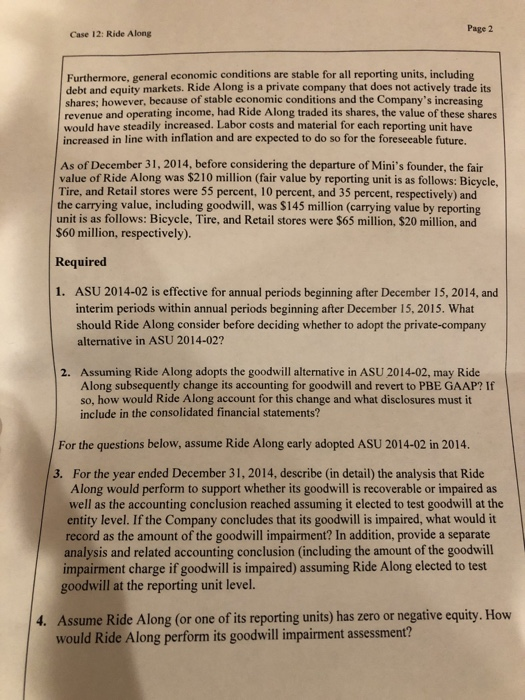Case 18-5 Ride Along In early 2001, Ride Along Corporation (Ride Along or the "Company"), a domestic company that does not meet the definition of a public business entity, began manufacturing and selling bicycles to retail stores nationally. Ride Along's fiscal year ends on December 31, and it has been experiencing growth over the past decade. Ride Along is required to prepare annual shareholders and the local bank. These financial statements are to be prepared in and issue annual consolidated financial statements to its accordance with U.S. GAAP. Ride Along is 73 percent owned by a private equity firm and 25 percent owned by its founder. The founder and private equity firm plan to either take Ride Along public in an initial public offering (IPO) or sell it to an existing public company in five years. Ride Along tests goodwill for impairment annually on November 30 and has determined that each of its goodwill reporting units is a legal entity On February 1, 2012, Ride Along acquired 100 percent ownership of a bicycle tire manufacturer, Mini Tires Company (Mini). The purposes of the acquisition were to reduce the cost associated with buying bicycle tires from third-party suppliers and for Ride Along to expand its operations by selling tires directly to retail stores. Mini met the definition of a business' but did not meet the definition of a public business entity (PBE) The founder of Mini will work as an employee of Ride Along and has signed a two-year noncompete agreement. Ride Along paid cash of $20 million (purchase price), which resulted in goodwill of S6 million and an intangible asset (a customer list) of $2 million. During 2013, Ride Along continued to gain market share in the bicycle industry and determined it wanted to own retail stores. On June 1,2013, Ride Along acquired 100 percent ownership of 10 independently owned retail stores and recorded $10 million of goodwill as part of the acquisitions. In January 2014, the FASB issued ASU 2014-02, Intangibles - Goodwill and Other (Topic 350): Accounting for Goodwill-a consensus of the Private Company Council. During 2014, the founder of Mini resigned from Ride Along and started a new business after his noncompete agreement expired. With his departure, 45 percent of the customer on Mini's original customer list, which was classified as an intangible asset on Ride Along's statement of financial condition, provided notice that they would no longer do business with Ride Along. This migration resulted in an impairment of the customer list intangible. These customers represent 35 percent of total future revenue for the Tire reporting unit and the loss of these customers reduced the fair value of Mini by 35 percent. No other management changes are expected. Even with the loss of Mini's customers, Ride Along performed well because of the strength of the retail stores and strong bicycle sales leading to results that exceeded expectations. Therefore, Ride Alor increased its revenue and operating income in its five-year forecast; cash flows contin to be positive In January 2017, the FASB issued ASU 2017-01, Business Combinations (Topic 805): Clarifying the Definition of a Business. This case does not assess whether the subject entities meet the definition of business, but rather, assumes as a fact that they do Copvright 2015 Deloitte Developm Page 2 Case 12: Ride Along Furthermore, general economic conditions are stable for all reporting units, including debt and equity markets. Ride Along is a private company that does not actively trade its shares; however, because of stable economic conditions and the Company's increasing revenue and operating income, had Ride Along traded its shares, the value of these shares would have steadily increased. Labor costs and material for each reporting unit have increased in line with inflation and are expected to do so for the foreseeable future. As of December 31, 2014, before considering the departure of Mini's founder, the fair value of Ride Along was $210 million (fair value by reporting unit is as follows: Bicycle, Tire, and Retail stores were 55 percent, 10 percent, and 35 percent, respectively) and the carrying value, including goodwill, was $145 million (carrying value by reporting unit is as follows: Bicycle, Tire, and Retail stores were $65 million, $20 million, and $60 million, respectively). Required 1. ASU 2014-02 is effective for annual periods beginning after December 15, 2014, and interim periods within annual periods beginning after December 15,2015. What should Ride Along consider before deciding whether to adopt the private-company alternative in ASU 2014-02 Assuming Ride Along adopts the goodwill alternative in ASU 2014-02, may Ride Along subsequently change its accounting for goodwill and revert to PBE GAAP? If so, how would Ride Along account for this change and what disclosures must it include in the consolidated financial statements? 2. For the questions below, assume Ride Along early adopted ASU 2014-02 in 2014. For the year ended December 31, 2014, describe (in detail) the analysis that Ride Along would perform to support whether its goodwill is recoverable or impaired as well as the accounting conclusion reached assuming it elected to test goodwill at the entity level. If the Company concludes that its goodwill is impaired, what would it record as the amount of the goodwill impairment? In addition, provide a separate analysis and related accounting conclusion (including the amount of the goodwill impairment charge if goodwill is impaired) assuming Ride Along elected to test oodwill at the reporting unit level 3. Assume Ride Along (or one of its reporting units) has zero or negative equity. How would Ride Along perform its goodwill impairment assessment? 4








